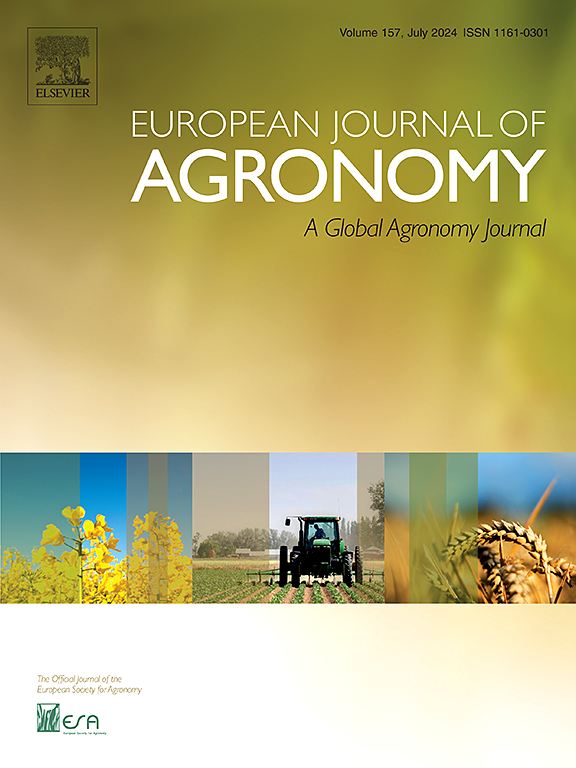欧洲-地中海地区未来气候变化下早期和中后期橄榄品种的物候期
IF 5.5
1区 农林科学
Q1 AGRONOMY
引用次数: 0
摘要
未来的气候变化可能会改变橄榄作物物候期的长度和时间。农艺实践(种植、灌溉、施肥、作物保护、收获等)的时机和管理是基于物候阶段和植物发育。因此,准确的物候评估对于确定气候风险和指导优化管理至关重要,有利于减轻气候变化对橄榄发育的影响。这项研究强调了欧洲-地中海地区早发芽和中晚发芽品种橄榄物候阶段(即发芽、开花和核硬化)的未来变化。基于EURO-CORDEX(协调区域气候降尺度试验)提供的历史(1976-2005)和未来(2036-2065)3种排放情景(RCP2.6、RCP4.5和RCP8.5)的0.11°高分辨率气候预估集合,我们应用寒流、抗寒流和生长日数组合模式预估了物候期的时间。结果表明,到2050年,超过75% %的研究区域将经历橄榄物候发育的显著提前,RCP8.5相对于其他rcp提前5 - 天。我们预测,在寒冷地区,由于持续的寒冷和未来变暖条件下增加的加热装置,橄榄物候提前(即20天)更大,表明气候适合橄榄生长,而地中海南部仍面临10-25天提前引起的高潜在物候干扰。未来品种间物候早性的差异(5-15天)表明,尽管中晚品种在北欧和较冷地区具有一致的热适应性,但地中海地区早品种的脆弱性。我们的研究强调了区域物候建模过程与指导未来气候变化下橄榄种植战略管理相关。本文章由计算机程序翻译,如有差异,请以英文原文为准。
The phenological phases of early and mid-late budbreak olive cultivars in a changing future climate over the Euro-Mediterranean region
Future climate changes will likely alter the length and timing of phenological phases of olive crop. The timing and management of agronomic practices (planting, irrigation, fertilization, crop protection, harvesting, etc.) are based on phenological phases and plant development. Consequently, accurate phenological assessments are essential to define climate risks and guide optimal management apt to mitigate climate change effects on olive development. This research highlights future changes in olive phenological phases (i.e., sprouting, blooming, and pit hardening) over the Euro-Mediterranean region for both early and mid-late budbreak cultivars. We apply a Chill, Anti-Chill, and Growing Degree Days combined model to project the timing of phenological phases based on an ensemble of high-resolution climate projections at 0.11° from EURO-CORDEX (Coordinated Regional Climate Downscaling Experiment) for historical (1976–2005) and future (2036–2065) periods under three emission scenarios (RCP2.6, RCP4.5, and RCP8.5). The results showed that more than 75 % of the study area would experience significant earlier phenological development for olive by 2050, with 5–10 days earlier relative advancement for RCP8.5 compared to other RCPs. We projected greater olive phenological advances (i.e.,>20 days) within colder areas due to persistent chilling and increasing heating units following future warming condition, indicating climate suitability for olive growth, while the southern Mediterranean is still facing high potential phenological disturbance induced by advances of 10–25 days. Future differences in phenological earliness between the cultivars (5–15 days) demonstrate the vulnerability of the early cultivar in the Mediterranean despite consistent thermal suitability for the mid-late cultivar in northern Europe and colder zones. Our investigation highlights regional phenological modeling processes relevant to guide strategic management of olive cultivation under future changing climate.
求助全文
通过发布文献求助,成功后即可免费获取论文全文。
去求助
来源期刊

European Journal of Agronomy
农林科学-农艺学
CiteScore
8.30
自引率
7.70%
发文量
187
审稿时长
4.5 months
期刊介绍:
The European Journal of Agronomy, the official journal of the European Society for Agronomy, publishes original research papers reporting experimental and theoretical contributions to field-based agronomy and crop science. The journal will consider research at the field level for agricultural, horticultural and tree crops, that uses comprehensive and explanatory approaches. The EJA covers the following topics:
crop physiology
crop production and management including irrigation, fertilization and soil management
agroclimatology and modelling
plant-soil relationships
crop quality and post-harvest physiology
farming and cropping systems
agroecosystems and the environment
crop-weed interactions and management
organic farming
horticultural crops
papers from the European Society for Agronomy bi-annual meetings
In determining the suitability of submitted articles for publication, particular scrutiny is placed on the degree of novelty and significance of the research and the extent to which it adds to existing knowledge in agronomy.
 求助内容:
求助内容: 应助结果提醒方式:
应助结果提醒方式:


